
Node.js has become the go-to option for developers to create powerful and scalable web applications. According to the 2022 StackOverflow Developer Survey, Node.js was named the most widely used web framework among professional developers. This success can be attributed to its large ecosystem, which provides many tools and frameworks. Understanding and embracing this ecosystem is critical to optimizing performance and simplifying the production process of any Node.js application.
In this article, we'll explore the top Node.js tools and frameworks for production environments to help you create the best possible Node.js applications.
1. Helios
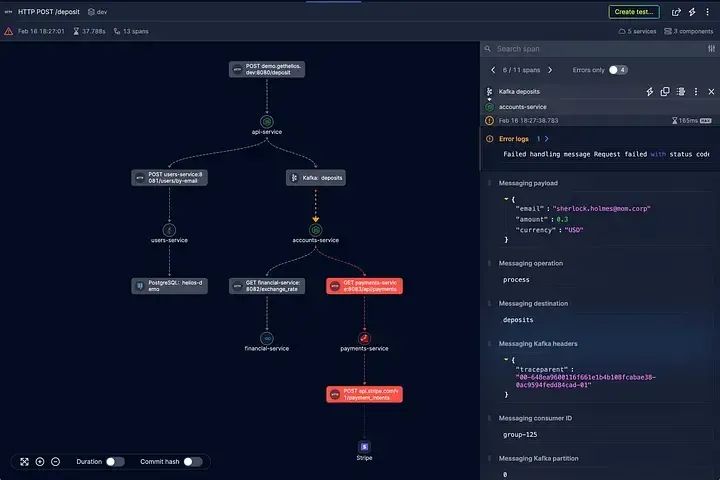
https://gethelios.dev/
Helios is a developer platform designed to provide a simplified solution for monitoring and troubleshooting Node.js applications with actionable insights.
The core goal of Helios is to help developers gain insight into the performance and behavior of their Node.js applications and optimize their operations by providing real-time data and actionable insights about the application. It provides developers with comprehensive visibility into monitoring across components such as microservices, serverless functions, databases, and third-party APIs by leveraging OpenTelemetry's context propagation framework.
Helios provides several powerful features to help developers easily monitor and troubleshoot their Node.js applications:
Multi-language support: Helios supports multiple programming languages, including Python, JavaScript, Node.js, Java, Ruby, .NET, Go, C++, and Collector. This enables developers to monitor and manage applications in multiple languages on a single platform.
Unified view of data flow: Helios provides a unified view of how application data flows between various components. Developers can easily understand the data delivery path and performance.
Accurate workflow reproduction: Helios can accurately reproduce workflows such as Lambda calls, HTTP requests, Kafka and RabbitMQ messages. This can be very helpful for diagnosing and debugging problems and to better understand the behavior of your application.
Easy integration with existing tools: Helios can be seamlessly integrated with existing logging, testing and error monitoring tools. This way, developers can comprehensively manage and monitor applications on a single platform without additional integration and configuration.
Visualization of complex data flows: Helios provides powerful visualization capabilities for displaying complex data flows, such as serverless calls, message queues, event flows, HTTP requests, and gRPC calls. This allows developers to more intuitively understand the data flow of the application.
By using Helios, developers can gain insight into the performance and behavior of their Node.js applications, quickly identify bottlenecks and efficiently resolve issues. Its multilingual support and seamless integration with existing tools make it a powerful choice for monitoring and optimizing production environments.
2. Sentry
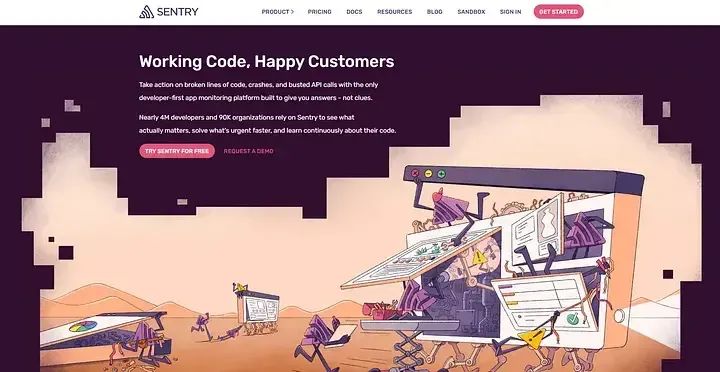
https://sentry.io/welcome/
Sentry is a powerful open source tool designed to help developers effectively identify and resolve application issues. It provides not only error monitoring, but also performance analysis, integration, session playback, performance monitoring, and code coverage report generation. With Sentry, you have a comprehensive toolkit that improves application reliability and eases debugging.
Features of Sentry include:
Major programming languages and frameworks are supported, including JavaScript, Python, Ruby, Node.js, Go, .Net, Android, and iOS.
Real-time application monitoring.
Support for custom queries.
data visualization.
End-to-end distributed tracing.
Sentry's multilingual support makes it a widely used tool for developers across different technology stacks. With real-time application monitoring, you can track the health of your applications and spot problems in time. The custom query function enables you to obtain specific data according to your needs. The data visualization function can display complex application data in an intuitive way to help you better understand and analyze the operation of the application. The end-to-end distributed tracing function helps to trace and analyze the calls and interactions between different components in the application.
Using Sentry, you can discover and solve problems in the application in time, and improve the reliability and stability of the application. Whether it's a small project or a large application, Sentry provides you with powerful tools and features to simplify the debugging process and optimize the performance of your application.
Note that Sentry is an open source tool, you can customize and configure it according to your needs. It is recommended to learn more about Sentry's documentation and features before using it in order to maximize its benefits and potential.
3. So
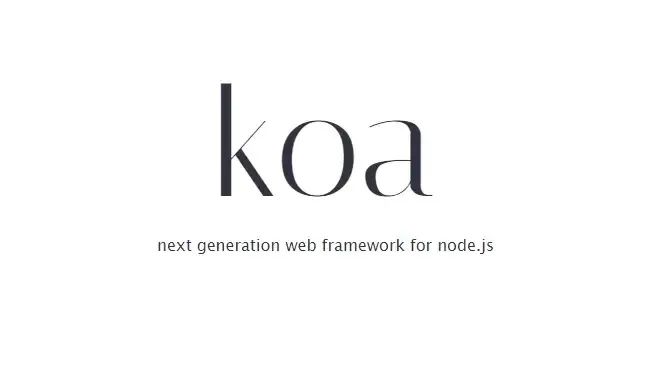
https://koajs.com/
Koa is a lightweight, flexible web application framework designed for Node.js. Created by the same team as Express.js, Koa prioritizes enhancing code readability and provides a clean API for building web applications. Whether you're developing a small project or a large-scale application, Koa's lightweight nature and adjustable architecture make it an ideal choice. Notably, Koa has more than 1 million downloads per week on NPM, underscoring its popularity among developers.
Features of Koa include:
Improved middleware flow control. Koa provides a more flexible middleware process control mechanism, enabling developers to more precisely control the execution order and conditions of middleware.
Async/await support for cleaner code. Koa natively supports async/await syntax, enabling developers to write asynchronous code that is easier to understand and maintain.
Simplified error handling and request/response manipulation. Koa provides simple and flexible ways to handle errors and allows developers to customize and manipulate requests and responses.
Highly extensible, allowing for the addition of custom features and integrations. Koa's architecture is very flexible, allowing developers to easily add custom functionality and integrate third-party libraries to meet specific needs.
By using Koa, developers can build Node.js applications more efficiently, improving code quality and maintainability. Its streamlined API and elegant design make the development process more concise and clear, while providing enough flexibility to adapt to the needs of various projects.
Note that Koa is a separate framework and distinct from Express.js. When choosing to use Koa, it is recommended to study its documentation and examples in detail in order to take full advantage of its features and benefits. Whether you are a novice or an experienced developer, Koa is a powerful tool worth exploring and using.
4、Express.js
Express.js is a very popular Node.js web application framework known for its simplicity and minimalist design. It provides developers with a comprehensive set of features for building scalable and efficient web applications.
A key advantage of Express.js is its excellent performance and scalability. It has an efficient routing system that enables applications to manage large numbers of concurrent connections without degrading performance. Notably, Express.js has a large user base, with more than 26 million weekly NPM downloads, further underscoring its widespread adoption and reliability.
Express features include:
Minimalist and unbiased framework. Known for its clean design and flexible features, Express.js provides the most basic tools and functions to enable developers to build web applications according to their needs.
Rich ecosystem with numerous middleware and extensions. Express.js has a large ecosystem that includes many middleware and extensions, enabling developers to quickly build feature-rich applications and customize them according to their needs.
Excellent routing and request handling capabilities. Express.js provides a flexible and powerful routing system, enabling developers to easily handle different routes and requests, and implement custom request processing logic.
Simplified error handling and exception handling methods. Express.js provides a simplified way to handle errors and exceptions, developers can easily catch and handle errors, and provide friendly error prompts and responses.
Flexible routing system. Express.js has a flexible routing system that enables developers to define and manage routing according to their own needs, and implement customized routing logic for applications.
By using Express.js, developers can easily build efficient and scalable Node.js web applications. Its clean design and rich features make it the framework of choice for developers. Whether building small projects or large-scale applications, Express.js provides flexible tools and features to help developers develop web applications more efficiently.
Note that understanding the basic concepts and syntax of Express.js is a prerequisite for using it. It is recommended to read the official documentation and examples of Express.js in detail to take full advantage of its features and advantages. As a widely adopted framework, Express.js has strong community support and abundant resources to help developers solve various problems and challenges.
5. Adonis JS
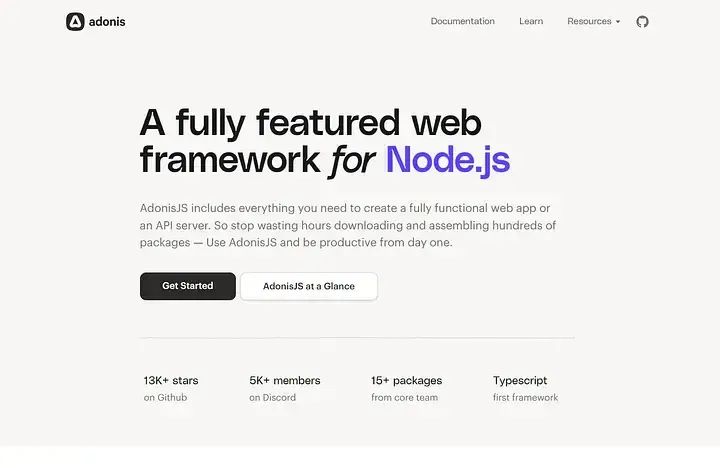
https://adonisjs.com/
AdonisJS is a feature-rich web application framework built on Node.js, following the MVC (Model-View-Controller) architectural pattern. It provides developers with a structured and well-organized way to develop web applications. Although relatively new to Express, AdonisJS offers ample documentation and a diverse ecosystem of plugins and extensions, enabling the creation of powerful and extensible web applications.
Features of AdonisJS include:
Follow the MVC architecture. AdonisJS adopts the MVC architecture, which divides the logic of the application into models, views and controllers, providing a well-organized and maintainable development mode, enabling developers to build complex web applications more easily.
Support TypeScript. AdonisJS supports TypeScript development, providing type checking and a more rigorous programming experience, making the code more readable and maintainable.
Provides a powerful CLI for scaffolding and code generation. AdonisJS provides a powerful command line interface (CLI), enabling developers to quickly generate project structures and code templates to improve development efficiency.
ORM support, seamless database integration. AdonisJS provides ORM (Object Relational Mapping) support, enabling developers to easily interact and operate with the database, simplifying the development process of the data access layer.
By using AdonisJS, developers can build powerful and scalable web applications in a structured and well-organized manner. AdonisJS provides many convenient functions and tools to help developers improve development efficiency and follow best practices. Although relatively new, AdonisJS has active support in the community and a growing user base, making it a framework worth exploring and using.
Note that AdonisJS is a great choice for developers familiar with the MVC pattern and Node.js. It is recommended to read the documentation and examples of AdonisJS in detail to understand its core concepts and syntax. With AdonisJS, you can quickly build high-quality and scalable web applications, and share and exchange experiences with other developers in the community.
6. FeathersJS
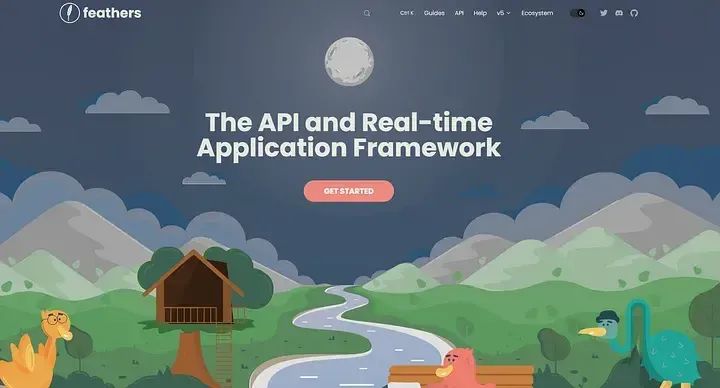
https://feathersjs.com/
FeathersJS is a full-stack web framework built on Node.js for creating APIs and real-time web applications. It supports TypeScript and JavaScript and seamlessly integrates with front-end frameworks like React, VueJS, Angular, React Native, Android or iOS. FeathersJS has more than 50,000 weekly NPM downloads.
Features of FeathersJS include:
Real-time functionality based on WebSockets and REST API. FeathersJS provides real-time functionality, enabling developers to easily build web applications that support real-time data transfer. It provides support for WebSockets and REST API to meet the needs of different application scenarios.
Pluggable architecture for scalability. FeathersJS adopts a pluggable architecture, which enables developers to easily add custom functions and extensions according to their needs. This architecture provides flexibility and scalability, enabling applications to adapt to changing needs.
Authentication and authorization support out of the box. FeathersJS provides out-of-the-box support for authentication and authorization, enabling developers to easily implement user authentication and access control. This simplifies the development process while improving application security.
Various databases are supported, including MongoDB, MySQL, PostgreSQL, etc. FeathersJS supports a variety of commonly used databases, enabling developers to flexibly select and integrate databases that suit their needs to achieve data storage and retrieval functions.
By using FeathersJS, developers can quickly build full-stack web applications, including APIs and real-time functions. FeathersJS provides a rich set of features and tools that enable developers to build and manage applications more efficiently. Whether building small APIs or large-scale real-time applications, FeathersJS provides developers with power and flexibility.
Note that understanding the basic concepts and syntax of FeathersJS is a prerequisite for using it. It is recommended to read the documentation and examples of FeathersJS in detail to take full advantage of its features and advantages. FeathersJS has active community support and a large user base. Developers can get support from the community and participate in exchanges to jointly promote the development and improvement of FeathersJS.
7. HapiJS
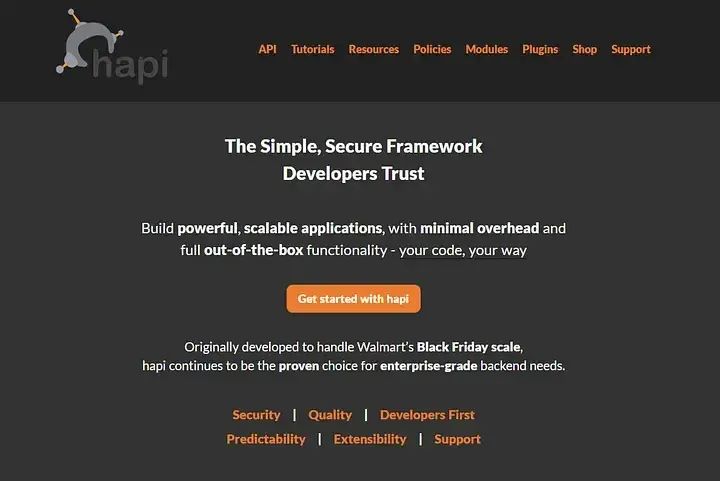
https://hapi.dev/
HapiJS is a powerful open source web framework designed to develop secure and scalable APIs and web applications. With a focus on flexibility, scalability, and security, HapiJS is an excellent choice for building production-grade Node.js applications.
Whether working on a small project or developing a large-scale enterprise application, HapiJS provides you with the necessary tools and features for a seamless and efficient development process. Notably, HapiJS has a large user base with over 600,000 weekly NPM downloads, further evidence of its reliability and popularity among the developer community.
Features of HapiJS include:
Rich ecosystem with a wide range of official plugins. HapiJS provides a large ecosystem with many official plugins that provide developers with more functionality and extensibility. These plugins enable developers to quickly build rich and complex applications for a variety of needs.
Highly scalable. HapiJS has a highly extensible architecture, enabling developers to customize and extend it according to the needs of the application. This makes HapiJS suitable for projects of all sizes, from small applications to large enterprise applications.
Comprehensive validation and input handling mechanisms. HapiJS provides a comprehensive validation and input processing mechanism to help developers ensure data integrity and security. It provides various validation options and plugins that simplify the process of data validation and processing.
Built-in caching, authentication and authorization support. HapiJS has built-in support for caching, authentication, and authorization, enabling developers to easily add these common features, improving application performance and security.
Support for encrypted and signed cookies, key rotation, and HTTP security headers. HapiJS supports encrypted and signed cookies, key rotation, and HTTP security headers, providing security and protection mechanisms to help developers ensure the security of application data and communications.
By using HapiJS, developers can build secure, reliable, and scalable Node.js applications. HapiJS provides a wealth of features and tools to enable developers to build and manage applications more efficiently and meet various needs. It is recommended to read the documentation and examples of HapiJS in detail to fully understand its functions and usage, and participate in community exchanges to obtain support and share experience. A favored framework, HapiJS provides developers with a reliable and powerful platform for building Node.js applications of all sizes.
8. NestJS
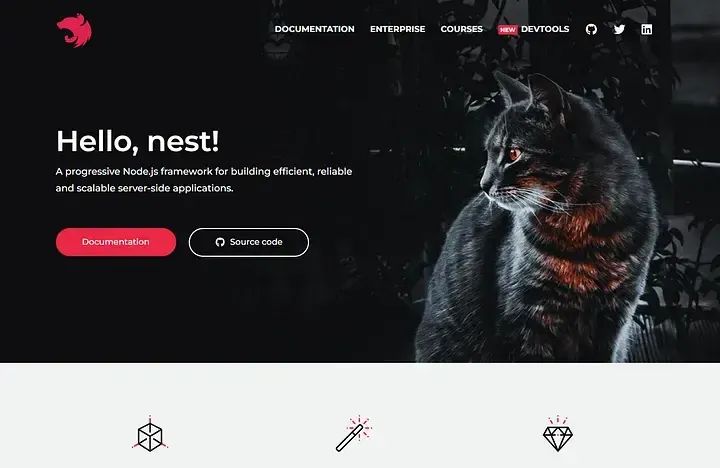
https://nestjs.com/
NestJS is an advanced Node.js framework that focuses on efficiency and scalability when developing server-side applications. By leveraging the power of TypeScript, NestJS improves the development experience and enables developers to create well-structured and reliable code.
The flexibility of NestJS makes it suitable for a variety of use cases, suitable for both small and large projects. NPM has more than 2 million downloads per week, underscoring its popularity and widespread use among developers. With NestJS, developers can easily build efficient and scalable server-side applications.
Features of NestJS include:
Built-in support for TypeScript and modern JavaScript features. NestJS has built-in support for TypeScript and modern JavaScript features, allowing developers to take full advantage of these features, improving code readability and maintainability.
Dependency injection for modular and testable code. NestJS provides support for dependency injection, enabling developers to write modular and testable code. This modular approach to development makes the code easier to understand, extend, and test.
Comprehensive module system and powerful command line interface (CLI). NestJS provides a comprehensive module system to help developers organize and manage the various modules of the application. At the same time, it also provides a powerful command line interface for generating and managing various parts of the project to improve development efficiency.
Provides a centralized and customizable exception handling mechanism. NestJS provides a centralized exception handling mechanism that enables developers to easily handle and manage exceptions in applications. Developers can customize exception handling logic according to their own needs.
Built-in support for WebSockets. NestJS has built-in support for WebSockets, enabling developers to easily build applications with real-time communication capabilities. This makes developing real-time applications and chat applications easier and more efficient.
By using NestJS, developers can take advantage of its powerful features and tools to build efficient and scalable server-side applications. It is recommended to read the NestJS documentation and examples in detail to understand its basic concepts and usage, and participate in community exchanges to obtain support and share experiences. As a modern framework, NestJS provides a reliable and powerful platform to help developers build server-side applications of all sizes.
9. WonderGraph
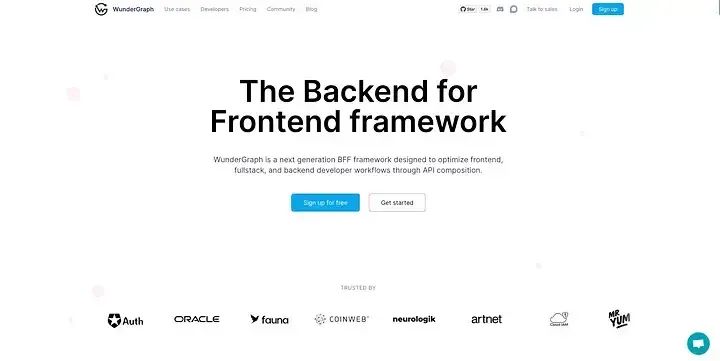
https://wundergraph.com/
WunderGraph is a next-generation BFF (front-end-back-end) framework that acts as a middleware between front-end applications and back-end services. It abstracts the complexity of APIs, simplifies the acquisition and manipulation of data, and enables developers to optimize the development process and improve the performance of applications.
Features of WunderGraph include:
Automatic caching and intelligent request deduplication. WunderGraph automatically handles caching and request deduplication, reduces the sending of repeated requests, and provides an efficient data acquisition and processing mechanism.
Seamless integration with existing REST, GraphQL and gRPC APIs. WunderGraph can seamlessly integrate existing REST, GraphQL and gRPC APIs, enabling developers to manage and consume multiple types of APIs on a unified platform.
Advanced performance monitoring and analysis. WunderGraph provides advanced performance monitoring and analysis functions to help developers understand and optimize application performance and provide better user experience.
Provides a unified GraphQL layer to access multiple APIs. WunderGraph provides a unified GraphQL layer, enabling developers to access multiple APIs through one interface, and achieve data aggregation and integration.
Provides granular security and authorization controls. WunderGraph provides fine-grained security and authorization controls, enabling developers to define and manage API access permissions, ensuring data security and compliance.
By using WunderGraph, developers can simplify communication and data processing between front-end and back-end, improving development efficiency and application performance. It is recommended to read the documentation and examples of WunderGraph in detail to understand its functions and usage, and try to apply it in actual projects. The innovation and feature-richness of WunderGraph make it a powerful tool for building modern and high-performance applications.
10. Artillery

https://www.artillery.io/
Artillery is a powerful open source load testing tool designed to evaluate the performance and scalability of web applications built with Node.js. Through its intuitive syntax, real-time metrics, and distributed testing capabilities, Artillery allows developers to proactively identify and resolve performance issues, ensuring a smooth and responsive user experience even under high load.
Artillery features include:
Scriptable load testing scenarios. Artillery provides scriptable load testing scenarios that enable developers to simulate various load scenarios, including high concurrency and complex user behavior, to more comprehensively evaluate application performance and scalability.
Real-time metrics and performance monitoring. Artillery provides real-time indicators and performance monitoring functions to help developers understand various indicators during load testing, including response time, throughput, and error rate. These metrics can help developers accurately assess application performance and optimize it.
Distributed load testing capabilities. Artillery supports distributed load testing, allowing tests to be run on multiple machines simultaneously, simulating a more realistic load situation. This helps to evaluate how the application will perform under high load.
Built-in support for WebSocket-based applications. Artillery has built-in support for WebSocket-based applications, enabling developers to fully load test such applications and obtain accurate performance data.
Provides real-time metrics for load testing, including response time, throughput, and error rates. Artillery provides real-time load testing indicators to help developers understand the performance of applications under different loads, including indicators such as response time, throughput, and error rate.
By using Artillery, developers can comprehensively assess the performance and scalability of applications, and discover and resolve potential performance issues in a timely manner. It is recommended to read Artillery's documentation and examples in detail to understand its functions and usage, and apply load testing during the development process to ensure that the application can still maintain efficient and stable performance in the face of a large number of concurrent users. Powerful and flexible, Artillery is a powerful tool for evaluating and optimizing web application performance.
Finish
Node.js is a multipurpose runtime environment with a wide range of uses in application development. While it may be easy to get started with Node.js, exploring its vast ecosystem of supporting tools is critical to realizing its potential.
For example, Helios is a valuable tool that enhances the debugging and troubleshooting process by providing comprehensive visibility into Node.js applications. In addition, many web and API development frameworks built on Node.js, such as Express, HapiJS, and FeatherJS, provide various templates and functions to simplify the development workflow.
Hope these tips help you in your Node.js application development. Thanks for taking the time to read.
Due to the limited space of the article, today’s content will be shared here. At the end of the article, I would like to remind you that the creation of the article is not easy. If you like my sharing, please don’t forget to like and forward it, so that more people in need can see it. At the same time, if you want to gain more knowledge of front-end technology, welcome to follow me, your support will be the biggest motivation for me to share. I will continue to output more content, so stay tuned.